|

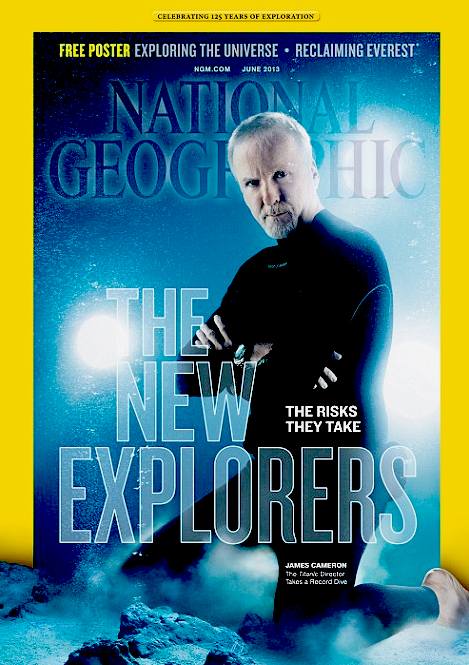
2014
- Movie poster: Deepsea Challenge 3D and National Geographic front cover
125 years of exploration
THE
MOVIE RELEASE AUGUST 2014 - SYNOPSIS - DEEPSEA CHALLENGE
3D
The documentary "Deepsea Challenge 3D" retreads the 2012 National Geographic Channel TV feature "James Cameron: Voyage to the Bottom of the Earth," chronicling the most ambitious among the 72 deep-submersible dives made by the "Avatar" filmmaker
- the one to Challenger Deep, the lowest known point on Earth, a depth of 35,787 feet in the Pacific Ocean's Mariana Trench east of the Philippines.
Cameron's obsession has been well documented in six nonfiction films that include the 2002 "Expedition: Bismarck" and 2003 "Ghosts of the Abyss." In case you are unfamiliar with "The Abyss," his 1989 box-office misfire starring Ed Harris, or haven't been following his extracurricular activities, "Deepsea Challenge 3D" reaches as far back as his childhood. His fascination with underwater expeditions includes the only other successful attempt at Challenger Deep by Don Walsh and Jacques Piccard in 1960.
James Cameron delves into the deepest and darkest point on Earth – the Mariana Trench – in the western Pacific Ocean near Guam to find out what's hidden in its watery depths.
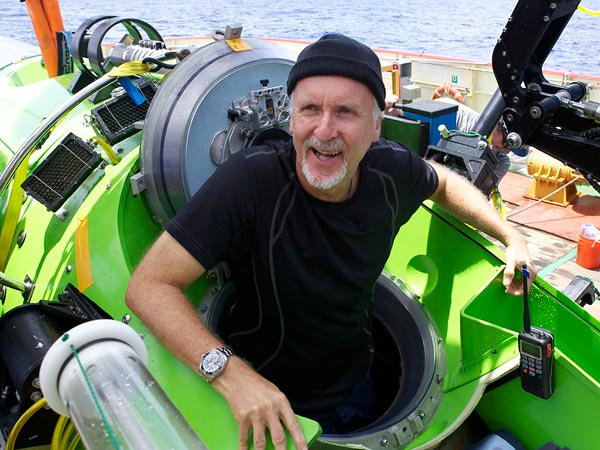
Looking
ship shape and Bristol fashion, James climbs aboard
Filmmaker and long-time underwater explorer, Cameron makes history in the upcoming documentary where viewers will witness engineers build the submersible for his journey and his solo odyssey into the unknown. It's a film about overcoming technical challenges, heart-wrenching tragedy and discovering the hidden depths of the underwater world.
Deepsea Challenge 3D is a Wight Expedition film in association with Beyond Productions, which has been nine years in the making – from planning, research, testing and filming the expedition. The documentary was executive produced by James Cameron, Lisa Truitt, Maria Wilhelm and Beyond's Managing Director and CEO, Mikael Borglund.
Filmed in 3D, viewers will feel like they're part of Cameron's deep-sea expedition. James Cameron, National Geographic Entertainment and Beyond Films presents Deepsea Challenge 3D in association with Earthship Productions.
What does Cameron encounter in the deep blue sea? You'll have to watch the film to find out for yourself. Deepsea Challenge 3D will be in theatres on 21 August 2014.
As a boy, filmmaker James Cameron dreamed of a journey to the deepest part of the ocean. This film is the dramatic fulfillment of that dream. It chronicles Cameron’s solo dive to the depths of the Mariana
Trench - nearly seven miles beneath the ocean’s surface - piloting a submersible he designed himself. The risks were astounding. The footage is
breathtaking. JAMES CAMERON’S DEEPSEA CHALLENGE 3D is a celebration of science, courage, and extraordinary human aspiration.

James Cameron and wife Suzy Amis attend the U.S. premiere of
'Deepsea Challenge 3D' at the American Museum of Natural History on August
4th 2014
THE CRITICS
“Fans of the director and oceanography gearheads should swoon to the immersive, visually spectacular images of the ocean floor.”
“The man’s passions are undeniable.”
“It proves more than worth the wait.”
— Scott Foundas, Variety
“It’s a fascinating, gripping and ultimately inspiring film.”
— Andrew Romano, The Daily Beast
“DEEPSEA CHALLENGE 3D shows the final frontier really is the ocean.”
— Stephen Schaefer, Boston Herald
“A journey unlike any other you’ve ever experienced! It takes you to another world, unseen by humans, and you feel you’re strapped in alongside James Cameron for an unforgettable thrill ride.”
— Jeffrey Lyons, Lyons Den Radio
“I loved it. I thought the film was just fascinating and I’m so glad I was able to see it. What a remarkable film!”
— Bonnie Tiegel, Entertainment Tonight
“Loved it. Immersive and intriguing. I enjoyed it thoroughly.”
— Mike Sargent, WBAI Radio
“This movie started out as nothing but a dream inside a boy, and now Cameron can say he’s done something no one else ever has.”
— Matt Donato, We Got This Covered
“A documentary worthy of acknowledgement and is enlightening to every age.”
— Gerald Wright, Film Showcase
“Exhilarating! Breathtaking! Riveting! Wondrous!”
— Avi Offer, The NYC Movie Guru
SUBMERSIBLE FACTS
• The pilot descended 35,787 feet (6.77 miles/10.90 km), but his ears didn’t pop during the journey; the pressure inside the pilot’s sphere stays constant.
• Crammed with equipment and just 43 inches (109 centimeters) wide, the interior of the pilot sphere is so small that the pilot had to keep his knees bent and could barely move.
• Just like a car, the sub is equipped with “cruise control” so the pilot can hover exactly where he wants to or glide through the water at a constant speed.
• Water vapor from the pilot’s breath and sweat condenses on the cold metal sphere and drains to a space where it’s sucked into a plastic bag. In an emergency, the pilot can drink it.
• The pilot chamber is a sphere because it’s the strongest shape for resisting pressure—if the pilot sat in a cylinder, the walls would need to be three times thicker.
• The sub’s giant beam of syntactic foam shrunk about 2.5 inches (6.4 centimeters) under the immense water pressure at the bottom of Challenger Deep.
• While the sub appears to be one streamlined vessel, the sphere is attached to the foam beam by polyester straps.
• If the sub’s 1,100 pounds (500 kilograms) of ballast weights don’t drop when commanded, a back-up galvanic release will corrode in the seawater within a fixed period of time, freeing the sub to rise to the surface.
• Small “bladders” inside the oil-filled external battery boxes will take in seawater. These “compensation bladders,” made from medical drip bags, are a critical part of the deep-ocean electronics system because the oil compresses at depth.
• The submersible spins slowly as it descends and ascends. It’s engineered to do this so it doesn’t veer off track.
• The sub’s batteries are made up of over a thousand pouch-type lithium-ion cells, bigger versions of the batteries hobbyists use for model airplanes.
• More than 180 systems—from battery packs to sonar—are operating during dives.
• Every circuit board in the sub’s exterior electronics—over 1,500 of them—was designed and built specially for this vehicle.
• The sub’s four external cameras are a tenth the size of previous deep-ocean HD cameras. The housings were designed by the DEEPSEA CHALLENGE team, and the cameras themselves were created from scratch, from the sensor up.

Designed to sink strangely - and efficiently - upright, the 24-foot-tall (7-meter-tall) craft was eight years in the making. Among its advances is a specially designed foam that helps allow the new sub to weigh in at 12 metric tons, making it some 12 times lighter than the Trieste.
DAILY MAIL 25 MAY 2013 - JAMES CAMERON RELIVES HEART STOPPING DESCENT
He is no stranger to the power of the ocean, having made his name by recreating the sinking of the
Titanic to spectacular effect.
But James Cameron has admitted to moments of dread in the lead up to his latest marine adventure - which saw him become the first lone
human to reach the deepest realm of the Earth's oceans.
The director relives his record-breaking journey to the bottom of the Mariana Trench inside a '43-inch diameter steel ball' in
his 3D movie.
Seven miles beneath the surface of the western Pacific, the Mariana Trench is deeper than Mount Everest is high.
The director described the weeks spent imagining 'all the things that could go wrong' before the descent, but said that on the day of the dive his apprehension was replaced by
'childlike excitement'.
The cramped pilot's chamber, into which he was crammed 'like a walnut in its
shell', was not claustrophobic, but 'snug and comforting', Cameron writes in the magazine.
"I feel surprisingly calm. I am wrapped in the sub, a part of it and it a part of me, an extension of my ideas and dreams,' the director said of the day of the dive.
As co-designer, I know its every function and foible intimately. There's no apprehension at this point, only determination to do what we came out here for, and childlike excitement for what's
ahead."
Cameron spent about three hours at the bottom of the ocean off the island of Guam, the deepest-known part of any ocean in the world.
He shot some 3-D video during the dive, but admitted afterwards it was difficult to see much in the murky depths from his vantage point inside Deepsea Challenger.
The futuristic electric green submersible was launched off the Mermaid Sapphire in the western Pacific in March 2012.
The Avatar director revealed he cut the mission three hours short after hydraulic fluid started leaking into his sub. The 57-year-old described it as ‘a heck of a ride.’
Cameron planned to spend seven hours under water but decided to head back up after spotting the leak.
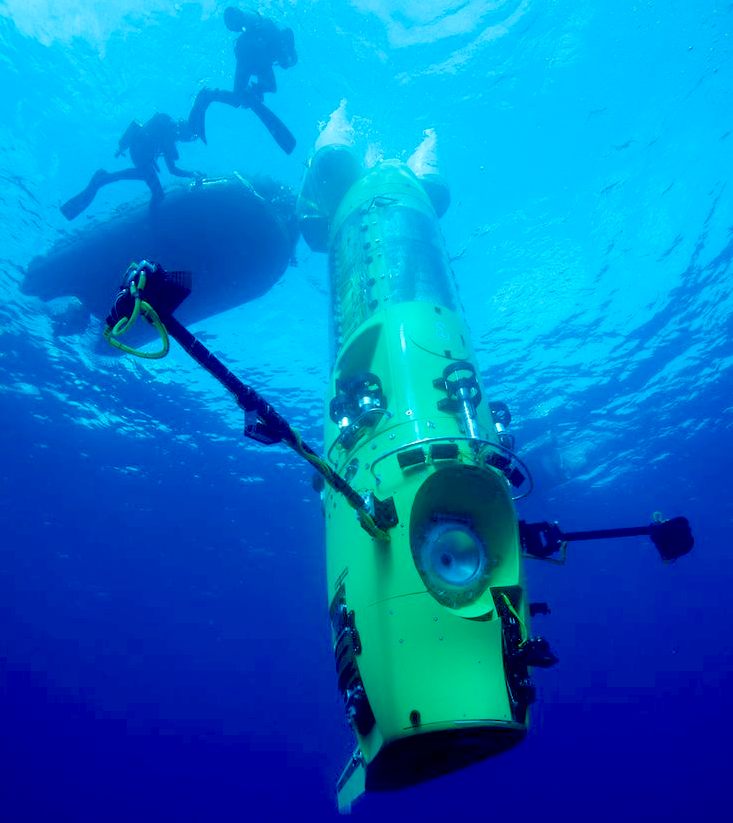
The
Deepsea Challenger leaving the surface
‘I saw a lot of hydraulic oil come up in front of the port. The port was coated with it. I couldn’t pick anything up so I began to feel like it was a moment of diminishing returns to go on,’ he explained.
‘I lost a lot of thrusters. I lost the whole starboard side. That’s when I decided to come up. I couldn’t go any further - I was just spinning in a circle,’ he added.
‘It was bleak. It looked like the moon. I didn’t see a fish. I didn’t see anything that looked alive to me, other than a few shrimplike amphipods in the water.'
He also realised how alone he was, with that much water above him.
‘It's really the sense of isolation, more than anything, realising how tiny you are down in this big vast black unknown and unexplored place,’ Cameron said.
Cameron said he had hoped to see some strange deep sea monster like a creature that would excite the storyteller in him and seem like out of his movies, but he didn't.
He didn't see tracks of animals on the sea floor as he did when he dove more than five miles deep weeks ago. All he saw were voracious shrimp-like critters that weren't bigger than an inch.
But that was okay, he said, it was all about exploration, science and discovery. He is the only person to dive there solo, using a sub he helped design. He is the first person to reach that depth - 35,576 feet - since it was initially explored in 1960.
He spent more than three hours at the bottom, longer than the 20 minutes Don Walsh and Jacques Piccard spent in the only other visit 52 years ago. But it was less than the six hours he had hoped. He said he would return.
‘I see this as the beginning,’ Cameron said. ‘It's not a one-time deal and then moving on. This is the beginning of opening up this new frontier.’
‘To me, the story is in the people in their quest and curiosity and their attempt to understand,’ Cameron said.

David
emerges triumphant with both thumbs signifying elation
His return aboard his 12-ton, lime-green sub called Deepsea Challenger was a ‘faster-than-expected 70-minute ascent,’ according to National Geographic, which sponsored the expedition. Cameron is a National Geographic explorer-in-residence.
The only thing that went wrong was the hydraulics on the system to collect rocks and critters to bring them back to land. Just as he was about to collect his first sample, a leak in the hydraulic fluid sprayed into the water and he couldn't bring anything back.
When Cameron climbed into his sub, it was warm because it was near the equator and his cramped vehicle - his head hit one end and his feet the other - was toasty because of the heat given off by electronics. It felt ‘like a sauna’ with temperatures of more than 100 degrees Fahrenheit, he said.
But as he plunged into the deep, the temperature outside the sub dropped to around 36 degrees, he said.
The pressure on the sub was immense - comparable to three SUVs resting on a toe. The super-strong sub shrank three inches under that pressure, Cameron said.
‘It's a very weird environment,’ Cameron said. ‘I can't say it's very comfortable. And you can't stretch out.’
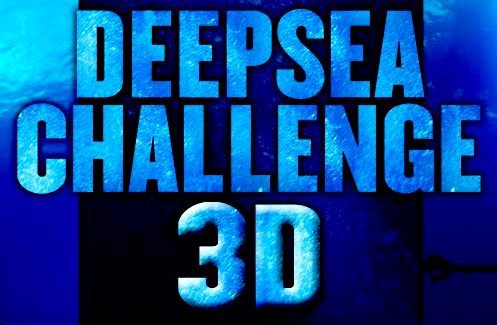
Film
logo in bold typeset
CAMERON
GAVE TWO THUMBS UP WHEN HE RESURFACED
The scale of the trench is hard to grasp - it is 120 times larger than the Grand Canyon and more than a mile deeper than Mount Everest is tall.
The film director has been an oceanography enthusiast since childhood and has made 72 deep-sea submersible dives.
Thirty-three of those dives have been to the wreckage of the Titanic, the subject of his 1997 hit film.
The following is an extract from the full article by James Cameron, which appears in the June issue of National Geographic:
The pilot’s chamber is a 43-inch-diameter steel ball, and I’m packed into it like a walnut in its shell, my knees pushed up in a hunched sitting position, my head pressed down by the curve of the hull. I’ll be locked in this position for the next eight hours. My bare feet rest on the 400-pound steel hatch, locked shut from the outside. I’m literally bolted in.
People always ask me if I get claustrophobic in the sub. To me it just feels snug and comforting. My visual field is filled by four video screens, three showing views from the external cameras, one a touch screen instrument panel.
The sub, painted electric green, is hanging upright in the swells like a vertical torpedo aimed at the center of the Earth. I tilt my 3-D camera, out on the end of its six-foot boom, to look up the face of the sub. The divers are getting into position to release the buoyant lift bag attached to the sub, holding it at the surface.
I’ve had years to contemplate this moment, and I won’t say there hasn’t been dread in the past few weeks, thinking about all the things that could go wrong. But right now I feel surprisingly calm. I am wrapped in the sub, a part of it and it a part of me, an extension of my ideas and dreams.
As co-designer, I know its every function and foible intimately. After weeks of pilot training, my hand goes to a specific control or switch without thinking. There’s no apprehension at this point, only determination to do what we came out here for, and childlike excitement for what’s ahead.
He spent more than three hours at the bottom, longer than the 20 minutes Don Walsh and Jacques Piccard spent in the only other visit 52 years ago. But it was less than the six hours he had hoped. He said he would return.
‘I see this as the beginning,’ Cameron said. It's not a one-time deal and then moving on. This is the beginning of opening up this new frontier.
To me, the story is in the people in their quest and curiosity and their attempt to understand,’ Cameron
is quoted as saying.
His return aboard his 12-ton, lime-green sub called Deepsea Challenger was a ‘faster-than-expected 70-minute ascent,’ according to National Geographic, which sponsored the expedition. Cameron is a National Geographic explorer-in-residence.
The only thing that went wrong was the hydraulics on the system to collect rocks and critters to bring them back to land. Just as he was about to collect his first sample, a leak in the hydraulic fluid sprayed into the water and he couldn't bring anything back.
When Cameron climbed into his sub, it was warm because it was near the equator and his cramped vehicle - his head hit one end and his feet the other - was toasty because of the heat given off by electronics. It felt ‘like a sauna’ with temperatures of more than 100 degrees Fahrenheit, he said.
But as he plunged into the deep, the temperature outside the sub dropped to around 36 degrees, he said.
The pressure on the sub was immense - comparable to three SUVs resting on a toe. The super-strong sub shrank three inches under that pressure, Cameron said.
‘It's a very weird environment,’ Cameron said. ‘I can't say it's very comfortable. And you can't stretch out.’

The
crane ship, Mermaid Sapphire swings the submersible out into the Pacific
Arnold Schwarzenegger, who appeared in Cameron's Terminator films, showed his support for the director via Twitter. 'Congrats to my great friend on the deepest solo dive ever. Always a pioneer'.
Richard Branson and Jessica Alba were just a couple of the other celebrities who got behind Cameron's journey.
The scale of the trench is hard to grasp - it is 120 times larger than the Grand Canyon and more than a mile deeper than Mount Everest is tall.
The film director has been an oceanography enthusiast since childhood and has made 72 deep-sea submersible dives.
Thirty-three of those dives have been to the wreckage of the Titanic, the subject of his 1997 hit film.
The following is an extract from the full article by James Cameron, which appears in the June issue of National Geographic:
The pilot’s chamber is a 43-inch-diameter steel ball, and I’m packed into it like a walnut in its shell, my knees pushed up in a hunched sitting position, my head pressed down by the curve of the hull. I’ll be locked in this position for the next eight hours. My bare feet rest on the 400-pound steel hatch, locked shut from the outside. I’m literally bolted in.
People always ask me if I get claustrophobic in the sub. To me it just feels snug and comforting. My visual field is filled by four video screens, three showing views from the external cameras, one a touch screen instrument panel.
The sub, painted electric green, is hanging upright in the swells like a vertical
torpedo aimed at the center of the Earth. I tilt my 3-D camera, out on the end of its six-foot boom, to look up the face of the sub. The divers are getting into position to release the buoyant lift bag attached to the sub, holding it at the surface.
I’ve had years to contemplate this moment, and I won’t say there hasn’t been dread in the past few weeks, thinking about all the things that could go wrong. But right now I feel surprisingly calm. I am wrapped in the sub, a part of it and it a part of me, an extension of my ideas and dreams.
As co-designer, I know its every function and foible intimately. After weeks of pilot training, my hand goes to a specific control or switch without thinking. There’s no apprehension at this point, only determination to do what we came out here for, and childlike excitement for what’s ahead.

Rolex has introduced a new version of its Deepsea Watch on the occasion of the release of National Geographic’s Deepsea Challenge 3D film about the expedition to the deepest reaches of the ocean by explorer and film-maker James Cameron. The newest iteration of the iconic watch was launched on 4 August in New York during the US premiere of National Geographic’s Deepsea Challenge 3D film documentary film in the splendid Hall of Ocean Life at the American Museum of Natural History in the presence of James Cameron and other personalities. It features a “D-blue” dial representing the colors of the deep. The deep blue to pitch-black gradient dial is reminiscent of the ocean’s twilight zone where the last trickle of light from the surface disappears into the abyss.
The new-generation divers’ watch benefits from exclusive innovations developed by Rolex to exceed the most exacting demands of professional divers. The Rolex Deepsea defines new standards of robustness, precision, functionality and reliability. In essence, the Rolex Deepsea is the ultimate Oyster: a watch that defies the elements. Its 44 mm Oyster case, reinforced with the patented Ringlock System, was designed to provide the highest degree of resistance in a size that remains wearable and practical. The new Rolex Deepsea watch is closely based on the experimental Deepsea Challenge watch that James Cameron was wearing during his expedition into the Mariana Trench when he made a record-breaking solo dive 10,908 meters (35,787 feet) below the surface of the Pacific Ocean piloting the Deepsea Challenger submersible.
No other watch is engineered like the Rolex Deepsea. Waterproof to an extreme depth of 3,900 metres (12,800 feet), this new-generation divers’ watch benefits from exclusive innovations developed by Rolex to exceed the most exacting demands of professional divers. The Rolex Deepsea defines new standards of robustness, precision, functionality and reliability. In essence, the Rolex Deepsea is the ultimate Oyster: a watch that defies the elements. Its 44 mm Oyster case, reinforced with the patented Ringlock System, was designed to provide the highest degree of resistance in a size that remains wearable and practical. It is steeped in the pioneering spirit that led Rolex to invent the Oyster and develop, in the 1950s and 1960s, iconic divers’ watches like the Submariner and the Sea-Dweller.
The original Deepsea Challenge was not a commercially produced watch that is a super-sized version of the current generation Rolex Deepsea with its 3,900 meter water resistance rating. This was the watch James Cameron wore on his own wrist inside of the Deepsea Challenge submersible during his almost 7 hour long dive. As you can see on the chart above, the already substantially sized Deepsea with its 44 millimeter diameter and 17.7 mm thickness looks extremely small when compared to the monstrous Deepsea Challenge and its 51.4 millimeter wide and 28.5 thick case, designed to withstand a crippling 13.6 tons per square inch of pressure.
On August 8th, 2014, just four days after Rolex has announced the Rolex Deepsea Sea-Dweller D-Blue, Cameron's movie titled Deepsea Challenge 3D will premier in the United States, telling the story of his fantastic experience as the first successful solo dive to the Mariana Trench, as well as the incredible achievement of the Deepsea Challenger submersible and the wristwatch strapped to it.
 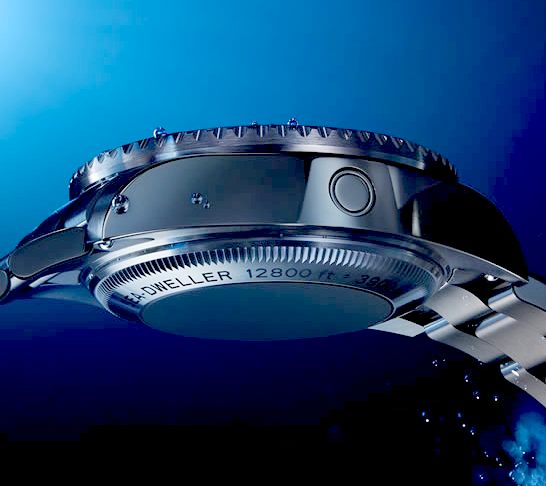
SPECIFICATIONS - OYSTER PERPETUAL ROLEX DEEPSEA
CATEGORY: Professional watch
REFERENCE: 116660
CASE: Oyster (monobloc middle case, screw-down
case back and winding crown). Ringlock System case architecture with nitrogen-alloyed steel ring Helium escape valve
DIAMETER: 44mm
MATERIALS: 904L steel, case back in grade 5 titanium
WINDING CROWN: Screw-down, Triplock triple water-proofness system
CROWN GUARD: Integral part of the middle case
CRYSTAL: Domed, 5.5 mm-thick, scratch-resistant, synthetic sapphire.
BEZEL: Unidirectional rotatable 60-minute graduated; Cerachrom insert made of ceramic, numerals and graduations coated in platinum via PVD
WATERPROOFNESS: 3,900 m (12,800 ft)
MOVEMENT: Calibre 3135, Manufacture Rolex Mechanical movement, bidirectional self-winding via Perpetual rotor
PRECISION: Officially certified Swiss chronometer (COSC)
FUNCTIONS: Centre hour, minute and seconds hands Instantaneous date with rapid setting, Stop-seconds for precise time setting
OSCILLATOR: Frequency: 28,800 beats / hour (4 Hz)
Paramagnetic blue Parachrom hairspring with Breguet overcoil
Large balance wheel with variable inertia, high-precision regulating via gold Microstella nuts
POWER RESERVE: Approximately 48 hours
BRACELET: Oyster; folding Oysterlock safety clasp with Rolex Glidelock system for fine adjustment of bracelet length, and Fliplock extension link
MARCH 25 2012 - NATIONAL GEOGRAPHIC
At noon on Monday, local time, (10 p.m. Sunday ET) James Cameron's "vertical torpedo" sub broke the surface of the western Pacific, carrying the National Geographic explorer and filmmaker back from the Mariana Trench's Challenger Deep—Earth's deepest, and perhaps most alien, realm.
The first human to reach the 6.8-mile-deep (11-kilometer-deep) undersea valley solo, Cameron arrived at the bottom with the tech to collect scientific data, specimens, and visions unthinkable in 1960, when the only other manned Challenger Deep dive took place, according to members of the National Geographic expedition.
After a faster-than-expected, roughly 70-minute ascent, Cameron's sub, bobbing in the open ocean, was spotted by helicopter and would soon be plucked from the Pacific by a research ship's crane. Earlier, the descent to Challenger Deep had taken 2 hours and 36 minutes.
Expedition member Kevin Hand called the timing of the DEEPSEA CHALLENGER sub's ascent "perfect."
"Jim came up in what must have been the best weather conditions we've seen, and it looks like there’s a squall on the horizon," said Hand, a NASA astrobiologist and National Geographic emerging explorer.
Before surfacing about 300 miles (500 kilometers) southwest of Guam, Cameron spent hours hovering over Challenger Deep's desert-like seafloor and gliding along its cliff walls, the whole time collecting samples and video.
Among the 2.5-story-tall sub's tools are a sediment sampler, a robotic claw, a "slurp gun" for sucking up small
sea-creatures for study at the surface, and temperature, salinity, and pressure gauges.
Now "the science team is getting ready for the returned samples," said NASA's Hand.
Cameron—best known for creating fictional worlds on film (Avatar, Titanic, The Abyss)—is expected to announce his initial findings later today. After analysis, full results are to be published in a future edition of National Geographic magazine.
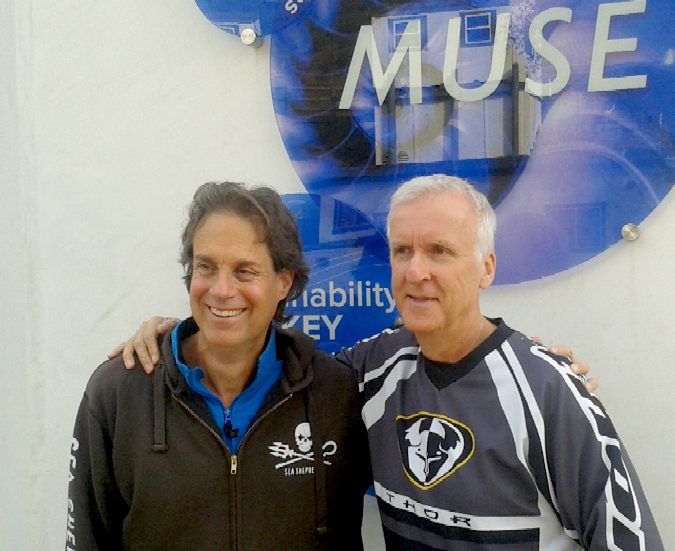
THE ULTIMATE TEST
Retired U.S. Navy Capt. Don Walsh, who descended to Challenger Deep in 1960, said he was pleased to hear that Cameron had reached the underwater valley safely.
"That was a grand moment, to welcome him to the club," Walsh, said in a telephone interview from the sub-support ship.
"There're only three of us in it, and one of them - late Swiss engineer Jacques Piccard
- is dead. Now it's just Jim and myself."
Expedition physician Joe MacInnis called Cameron’s successful descent today "the ultimate test of a man and his machine."
After breaching the ocean surface, the DEEPSEA CHALLENGER was first spotted by a helicopter owned by Microsoft co-founder Paul Allen, a longtime Cameron friend. Allen was on the scene for the historic dive and posted live updates of the event on Twitter from aboard his yacht, the Octopus, which is providing backup support for the mission.
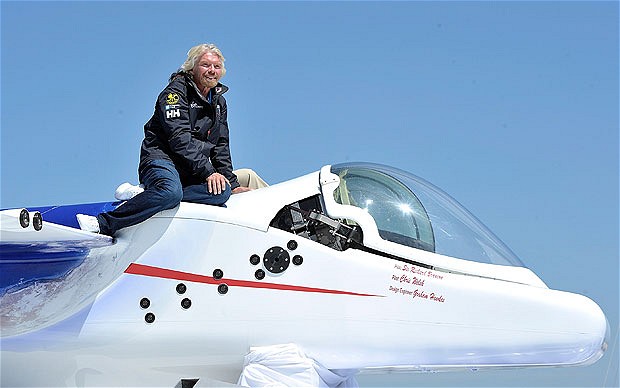
Sir
Richard Branson aboard his underwater steed
SCIENCE IN THREE DIMENSIONS
Throughout the Mariana Trench dive, 3-D video cameras were kept whirring, and not just for the benefit of future audiences of planned documentaries.
"There is scientific value in getting stereo images because ... you can determine the scale and distance of objects from stereo pairs that you can't from 2-D images," Cameron told National Geographic News before the dive.
But "it's not just the video. The sub's lighting of deepwater scenes—mainly by an 8-foot (2.5-meter) tower of LEDs—is "so, so beautiful," said Doug Bartlett, a marine biologist at the Scripps Institution of Oceanography in San Diego, California.
"It's unlike anything that you'll have seen from other subs or other remotely operated vehicles," said Bartlett, chief scientist for the DEEPSEA CHALLENGE project, a partnership with the National Geographic Society and Rolex. (The Society owns National Geographic News.)
MEDICAL & PSYCHOLOGICAL RIGORS
As the 57-year-old explorer emerged from the sub's coffin—tight 43-inch-wide (109-centimeter-wide) cockpit, a medical team stood at the ready.
But if recent test dives—including one to more than five miles (eight kilometers meters) down—are any indication, Cameron should be physically fine, despite having been unable to extend his arms and legs for hours, expedition physician Joe MacInnis told National Geographic News before the dive.
"Jim is going to be a little bit stiff and sore from the cramped position, but he's in really good shape for his age, so I don't expect any problems at all," said MacInnis, a long-time Cameron friend.
In addition, the sub's "pilot sphere" has a handlebar, which Cameron could use to pull himself occasionally up during the dive. "Usually, shifting position is all that's required to buy yourself another few hours," he said.
Because Cameron had prepared extensively for the dive, he should be in good psychological health, said Walter Sipes, an aeronautics psychologist at
NASA's Johnson Space Center.
"He's got prior experience doing this, not just in the simulator but also training dives ... and he's an adventurer, so I really don't think they'll have any issues to worry about," said Sipes, who is not part of the expedition.
Still, if Cameron plans to conduct more dives - which the team has indicated he will
- Sipes recommends he get plenty of rest in between or risk mental fatigue.
"When you start to get fatigued, you start making mistakes," he added. "And since he's down there solo, he can't afford that. He's a [potential] single-point failure."
It should be at least a few weeks before any further DEEPSEA CHALLENGE dives, as the director's next breakneck mission will take him from the middle of the Pacific to
London, where he's due at a premiere of his Titanic 3-D Wednesday.
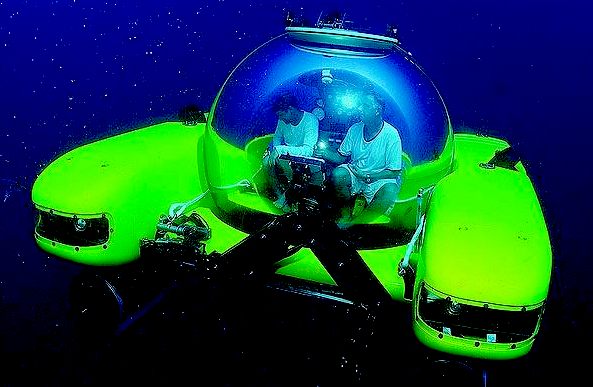
The
Triton 1000 submersible is capable of carrying 3 persons
A TURNING POINT
By returning humans to the so-called hadal zone - the ocean's deepest level, below 20,000 feet (6,000 meters)
- the Challenger Deep expedition may represent a renaissance in deep-sea exploration.
While remotely operated vehicles, or ROVs, are much less expensive than manned subs, "the critical thing is to be able to take the human mind down into that environment," expedition member Patricia Fryer said, "to be able to turn your head and look around to see what the relationships are between organisms in a community and to see how they're behaving—to turn off all the lights and just sit there and watch and not frighten the animals, so that they behave normally.
"That is almost impossible to do with an ROV," said Fryer, a marine geologist at the Hawai'i Institute of Geophysics & Planetology.
Andy Bowen, project manager and principal developer of the Nereus, an ROV that explored Challenger Deep in 2009, said a manned mission also has the potential to inspire public imagination in a way a robot can't.
"It's difficult to anthropomorphize machines in a way that engages everyone's imagination—not in the same way that having boots on the ground, so to speak, can do," said Bowen, who's not an expedition member.
Biological oceanographer Lisa Levin, also at Scripps, said that the DEEPSEA CHALLENGE program's potential for generating public interest in deep-ocean science is as important as any new species Cameron might have discovered.
"I consider Cameron to be doing for the trenches what Jacques Cousteau did for the ocean many decades ago," said Levin, who's part of the team but did not participate in the seagoing expedition.
At a time of fast-shrinking funds for undersea research, "what scientists need is the public support to be able to continue exploration and research of the deep ocean," Levin said.
Perhaps referring to his friend's most recent movie, expedition physician MacInnis called Cameron a real-world "avatar."
"He's down there on behalf of everybody else on this planet," he said. "There are seven billion people who can’t go, and he can. And he’s aware of that."
For his part, Cameron seems sure that the DEEPSEA CHALLENGER will be exploring the depths for a long time to come. In fact, he's so confident in his star vehicle, he started mulling sequels even before today's trench dive.
Phase two might include adding a thin fiber-optic tether to the ship, which "would allow science observers at the surface to see the images in real time," said Cameron, a National Geographic Society explorer-in-residence.
"And phase three might be taking this vehicle and creating a second-generation vehicle."
DEEPSEA CHALLENGE, then, may be anything but a one-hit wonder. To expedition chief scientist Bartlett, the Mariana Trench dive could "represent a turning point in how we approach ocean science.
"I absolutely think that what you're seeing is the start of a program, not just one grand expedition."

Location
map of the Mariana Trench
8 MARCH 2012 - SUBSEA WORLD
NEWS
Squeezed into a submersible as futuristic as anything in his movies, James Cameron intends to descend solo to the ocean's deepest point within weeks, the Canadian filmmaker and explorer announced Thursday.
Just Tuesday, during testing off Papua New Guinea, Cameron dived deeper than any other human has on a solo mission. Now he aims to become the first human to visit the Mariana Trench's Challenger Deep in more than 50 years—and to return with animals, images, and data that were unthinkable in 1960.
That year the two-person crew of the U.S. Navy submersible Trieste—still the only humans to have reached Challenger Deep—spent only 20 minutes at the bottom, their view obscured by silt stirred up by the landing (more on the Trieste dive).
By contrast, the Cameron-designed DEEPSEA CHALLENGER sub is expected to allow the explorer to spend about six hours on the seafloor. During that time he plans to collect samples and film the whole affair with multiple 3-D, high-definition cameras and an 8-foot-tall (2.4-meter-tall) array of LED lights.
Already the tech-laden sub has taken Cameron a record-breaking 5.1 miles (8.2 kilometers) straight down. That Tuesday dress rehearsal for Mariana made the DEEPSEA CHALLENGER the deepest-diving submersible in operation and the deepest-diving single-pilot sub in history.
Cindy Van Dover, a marine biologist at Duke University and a former pilot of the deepwater submersible
Alvin, said she hopes some of DEEPSEA CHALLENGER's technology will trickle down to the rest of the deep-ocean science community.
"I think some of the engineering feats that have to be overcome are some of the most exciting aspects of this project ... because going to such extreme depths will require some technological breakthroughs," said Van Dover, who is not involved in Cameron's dive attempt.
Despite its innovations, the DEEPSEA CHALLENGER's spherical steel cockpit just barely accommodates its single occupant—in this case, Cameron, the man behind Avatar, Titanic, The Terminator, and, fittingly, The Abyss.
Nothing in his fictional worlds could quite prepare him for real-life exploration, said Cameron, a veteran of dozens of deep-sea submersible dives.
"When you're making a movie, everybody's read the script and they know what's going to happen next," said Cameron, also a National Geographic Society explorer-in-residence, in a video statement.
"When you're on an expedition, nature hasn't read the script, the ocean hasn't read the script, and no one knows what's going to happen next."
Retired U.S. Navy Capt. Don
Walsh, who descended to Challenger Deep with Swiss engineer Jacques Piccard in the Trieste in 1960, said he was very pleased by the renewed interest in the Mariana Trench.
"I think it's about time," said Walsh, who is an advisor to the DEEPSEA CHALLENGE project and who will be with the Cameron team when the sub makes its Challenger Deep attempt.
"When Jacques and I surfaced from our deep dive, we were thinking about how long before someone else tries it, and we came to the conclusion that it would be about two years."
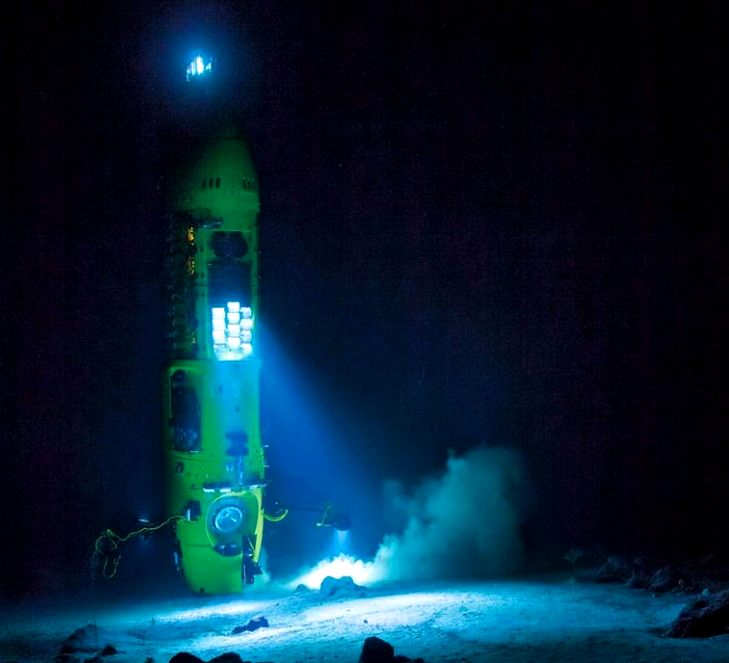
The
Deepsea Challenger settles on the ocean floor
MARIANA TRENCH STILL A MYSTERY
Cameron and his team will head for the Mariana Trench only after completing more tests—this time off the U.S. island territory of Guam (map), about 200 miles (320 kilometers) northeast of Challenger Deep.
The dive will be part of Cameron's DEEPSEA CHALLENGE project, a partnership with National Geographic and
Rolex that will take him and a crew of engineers, scientists, and filmmakers to the deepest ocean regions on Earth.
Cameron, 57, said he hopes the project will help answer some surprisingly basic scientific questions about ocean trenches, such as whether fish can live in the sea's deepest reaches.
(Despite a claimed sighting by a Trieste crewmember, the presence of fish in Challenger Deep is very much an open question. So far no
robotic mission has spotted fish there.)
"We're gonna go down there with our cameras, our lights, and find the answers to some of those questions," Cameron said.
CAMERON UNDER PRESSURE
The Mariana Trench is something of a 1,500-mile-long (2,550-kilometer-long) scar in the Pacific seafloor.
At Challenger Deep, the trench plummets 6.8 miles (11 kilometers) down
- if Mount Everest were dropped here, its summit would be more than a mile (1.6 kilometers) underwater.
"It's a place we can't get to, and we don't like not being able to get to places," Duke's Van Dover said. "It's something that gets to our psyche—we want to reach the impossible."
Because of its extreme depth, the trench is perhaps the most inhumane place on Earth: cloaked in perpetual darkness, chilled to near freezing. At the bottom, Cameron's craft will be subjected to water pressures approaching 16,000 pounds per square inch (1,125 kilograms per square centimeter).
"It would be about the equivalent of turning the Eiffel Tower upside down and resting it on your big toe," DEEPSEA CHALLENGE team member Patricia Fryer told National Geographic News. Fryer is a geologist at the Hawai'i Institute of Geophysics & Planetology
(HIGP).
The sub will actually shrink by about 2.5 inches (6.3 centimeters) during the descent.
Expedition leader Cameron said, "Every single fastener, every single way of joining structures on the sub had to be looked at very carefully, because otherwise stainless
steel bolts would just shear as the sub compressed."
Cameron isn't the only person dreaming of reaching the ocean's deepest point.
U.K. magnate Richard Branson has built a two-seater sub resembling a stubby-winged airplane, which he says can survive a Challenger Deep descent. Also, the Triton "luxury" submersible company last year unveiled the Triton 36000/3 model, which would reportedly allow a three-person crew to make the journey.
Of the current-day contenders, the DEEPSEA CHALLENGER looks as though it'll be first to the bottom
- and of course first to return.
Once Cameron flips a switch, an electromagnetic system is to jettison the heavy steel plates that allow the DEEPSEA CHALLENGER to sink
- sending the sub surface-ward like a cork.
The team estimates Cameron will be able to complete the descent in an hour and a half. The ascent should take about the same amount of time
- a far cry from the Trieste's five-hour descent and three-hour-plus ascent.
The trip, though, won't be a comfortable one for Cameron.
In the 43-inch-wide (109-centimeter-wide) steel "pilot sphere," the explorer won't be able to extend his arms or legs. And he'll have to share that scant space with snacks, a camera, joysticks, and a change of warmer clothing (more on what Cameron will experience).
"It's like a clown car in there," Cameron said. "You barely have room to get in, and then they hand you another 50 pounds [23 kilograms] of equipment."
Trieste co-pilot Walsh, who has seen the DEEPSEA CHALLENGER in person, said he was very impressed by its technology.
"When you look backward from when we dove ... it's like asking Orville Wright to compare his airplane to a 747," he said.
Nevertheless, when Cameron invited Walsh to sit in a mockup of the sub's cramped cockpit, he declined. "I just told him my body doesn't fold that way anymore."
TOTALLY ALIEN ANIMALS AWAIT
During the expected six-hour sea-bottom sojourn, Cameron will be able to use the DEEPSEA CHALLENGER's 12 propeller-driven thrusters to move up and down and side to side and to hover in place.
With a folding robotic arm, he'll be able to collect rocks, animals, and seafloor core samples for later study on the surface. (Related: "Life Is Found Thriving at Ocean's Deepest Point.")
Before Cameron's dive, the team also plans to send unmanned "landers" to the trench bottom. Resembling skinny phone booths, the 13-foot-tall (4-meter-tall),
camera-equipped submersibles will carry bait to lure sea creatures into plastic cylinders, which can be retrieved by the team when the landers surface.
"The animals on the inside are captured" and even after ascent, "still cold, still under pressure," Kevin Hardy, senior development engineer at the Scripps Institution of Oceanography in San Diego, California, and a member of the DEEPSEA CHALLENGE team, told
National Geographic.
Hardy predicts some of the specimens will be "totally alien" to scientists. "If you can imagine a wild animal, you'll find it down there."
Already, "science fiction is mimicking what we see for real in the deep ocean," he added. "And we haven't seen it all yet. There's a 'continent' we haven't explored down there."
Duke’s Van Dover is also excited about the scientific discoveries that could be lurking in the trench.
"Challenger Deep is one of those truly mysterious places where we're bound to discover many new species and different kinds of habitats that we haven't imagined before," she said.
"Many scientists would like to understand more about the pressure effects on physiology and biochemistry at those depths."

The
Deepsea Challenger is contained by several ropes during launch and
recovery
WHY SEND CAMERON?
While many of the scientific goals Cameron hopes to achieve with the DEEPSEA CHALLENGER could be accomplished with an unmanned sub, he believes the risk is worth it.
Piloting a submersible remotely, "you just don't get a sense of that situational awareness that you have when you're really down there," he said.
HIGP's Fryer agreed, saying a remotely operated vehicle (ROV) is no substitute for sending a human-occupied vehicle into the abyss.
"It's like the difference between night and day," Fryer said.
"The critical thing is to be able to take the human mind down into that environment, to be able to turn your head and look around to see what the relationships are between organisms in a community and to see how they're behaving, to turn off all the lights and just sit there and watch and not frighten the animals so that they behave normally.
"That is almost impossible to do with an ROV."
BURIED
SECRETS OF THE MARIANA TRENCH
In addition to the rare specimens that could be brought back for study, scientists say a Mariana Trench dive could help shed light on natural disasters and even the emergence of life on Earth.
Most tsunamis, for example, result from
earthquakes along faults called subduction zones, where one tectonic plate slowly slides beneath another, forming ocean trenches.
"What we've found by dredging the overriding plate on the inner slope of the [Mariana Trench] is that it exposes the upper part of the planet's mantle as well as the lower part of the Earth's crust and all the way up to the shallow crust," Fryer explained.
Close looks at such slopes could lead to a better understanding of the geological conditions that control earthquakes and provide valuable clues about the makeup of our planet.
Some scientists have also speculated that so-called mud volcanoes near the Mariana Trench could have served as incubators for the first
life-forms on
Earth.
"The amino acids that are essential for building the earliest cells are not stable at high temperatures" such as those at volcanic vents along shallower ocean ridges, Fryer said.
For those crucial molecules, she said, "you'd need a relatively cool environment and you'd need water"
- conditions present at Mariana Trench mud volcanoes.
OF COURSE I'M WORRIED
Cameron is well aware of the dangers involved in the Challenger Deep endeavor, and his team has built several safety precautions into the sub.
For example, if there's a power failure, the metal weights are to fall away, allowing the sub to surface. And if the weights don't disengage normally, a wire connecting them to the sub will corrode within about 12 hours.
Cameron will also have the option of using a heat-based method to break the bolts holding the plates
- which furthermore can be
electro-magnetically disengaged via a signal from a research vessel at the surface.
Even with multiple safeguards, Cameron isn't exactly carefree.
"Yeah, of course I'm worried," he said. "Worry is a good thing when you're an explorer.
I think when you're cavalier, when you take risk for granted—that's when you're going to get bitten."
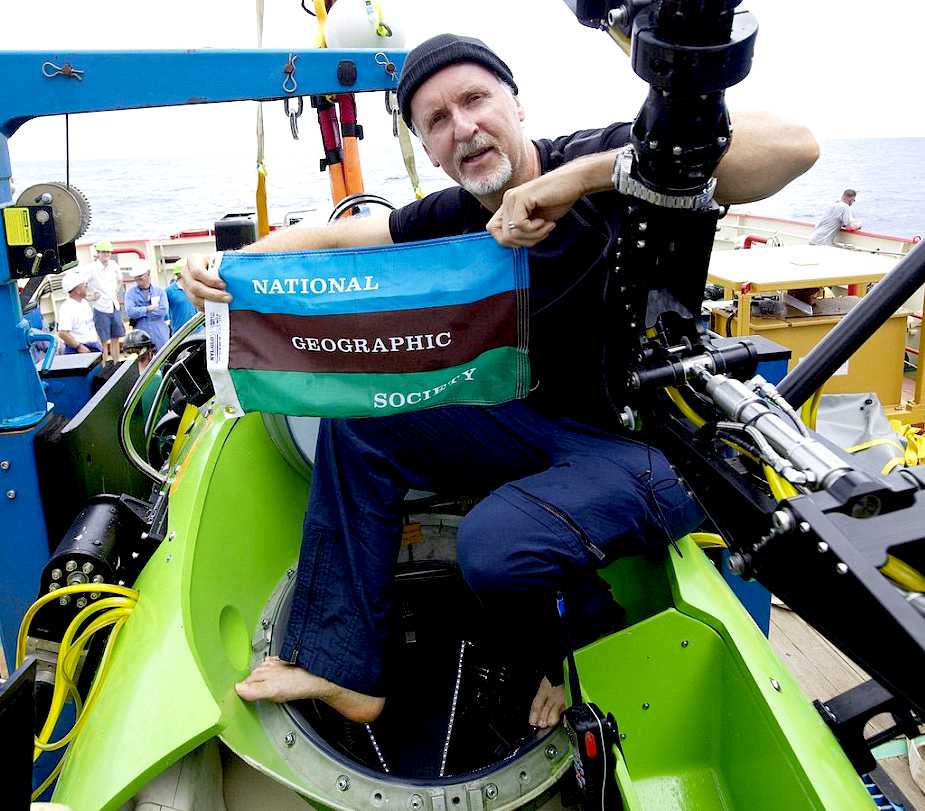
Barefoot
back to nature, David goes deeper than his previous missions
TELEGRAPH - 26 FEB 2012 - DIRECTOR JAMES CAMERON LEADS SUBMARINE RACE
Of four teams racing to get a submarine to the deepest spot in the world's oceans, that of film director James Cameron is closest to success and may dive to the Mariana Trench within weeks.
It is the lowest point in the world's oceans and one of the most forbidding spots on the
planet, cloaked in cold, darkness and enduring mystery.
Inhabited by organisms that resemble some of the earliest life-forms, it is deeper than Mount Everest is tall, with access so risky and complex that it has had just two human visitors since its formation
nine million years
ago.
Now, in what could be the culmination of a so-called "race to inner space",
Hollywood director James Cameron may be poised to dash the hopes of
Sir Richard Branson's Virgin Oceanic team of being the first 21st-century aquanaut to reach Challenger Deep, the nethermost location in any of the world's oceans.
America's civil submarine construction community is abuzz with word that the 57-year-old
Canadian film-maker is preparing to make a treacherous solo descent of the nearly 36,000ft deep abyss, located in the Pacific Ocean's Mariana Trench, within weeks.
Curling his 6ft 1in frame inside a cramped submersible built to withstand the crushing water pressure of 16,000 pounds per square inch – equivalent to 8,000
elephants standing on a
Mini Cooper – his attempt will, if successful, hand him a record that Virgin's pilot Chris Welsh had originally aimed to conquer by the end of last year.



SUBMARINE
INDEX
Alvin
- DSV submersible
HMS
Astute 1st of Class
BAE Systems
HMS
Vanguard- Trident
INS
Sindhurakshak - explosion
& sinking
Lusitania
- Torpedo
attack
Predator
- Covert submarine hunter/killer
Seawolf
- Autonomous wolf pack deployment of Predator mini-subs
Trieste
- Jacques Piccard, Don Walsh
U20
- Kapitan Leutnant Walther Schwieger
USS
Bluefish WWI submarine
USS
Bluefish - Nuclear submarine
USS
Flying Fish
USS
Nautilus - 1st nuclear submarine & subsea north pole passage

February
1960
- Trieste Bathyscaphe Life magazine cover
LINKS
Subsea
World News James-cameron-plans-to-dive-pacifics-mariana-trench
Daily
Mail
James-Cameron-relives-heart-stopping-descent-deepest-ocean-submersible-just-43-inches-wide
Telegraph
Film-director-James-Cameron-leads-submarine-race-to-the-bottom-of-the-Mariana-Trench
National
Geographic 2012 March James Cameron deepest mariana trench challenger
submersible
New
York
Daily News James Cameron's 3D movie Deepsea Challenge journey
Trailers
apple deepsea challenge 3d
IMDB
Deepsea Challenge 3S
A
blog to watch rolex-deepsea-d-blue-watch-james-cameron-challenge-3d-movie
Rolex
watches deepsea
Luxury
launches
new-rolex-deepsea-watch-celebrates-james-camerons-deepsea-challenge-3d-film
LA
Los Angeles Times
deepsea challenge movie review
Beyond
blog Deepsea Challenge 3d in Australian theatres aug 21
Rotten
tomatoes deepsea_challenge 3d
National
Geographic - Sloan
JPL
Jet Propulsion Laboratory NASA
UOG
- Scripps UCSD - UHM
Hawaii
Deepsea
Challenge
ABC
News James Cameron
Wikipedia
Bathyscaphe_Trieste
Rolex
blog spot 2010 deepest-deep-sea-dive-in-history-us
http://trailers.apple.com/trailers/independent/deepseachallenge3d/
http://www.imdb.com/title/tt2332883/
http://www.ablogtowatch.com/rolex-deepsea-d-blue-watch-james-cameron-challenge-3d-movie/
http://www.rolex.com/watches/rolex-deepsea/m116660-0003.html
http://luxurylaunches.com/watches/new-rolex-deepsea-watch-celebrates-james-camerons-deepsea-challenge-3d-film.php
http://www.latimes.com/entertainment/movies/la-et-mn-deepsea-challenge-movie-review-20140808-story.html
http://www.beyond.com.au/blog/beyond/2014/07/08/deepsea-challenge-3d-in-australian-theatres-aug-21
http://www.rottentomatoes.com/m/deepsea_challenge_3d/
http://www.nationalgeographic.com/
http://www.sloan.org/
http://www.jpl.nasa.gov/
http://www.uog.edu/
https://scripps.ucsd.edu/
http://www.uhm.hawaii.edu/
http://www.deepseachallenge.com/
http://abcnews.go.com/topics/entertainment/directors/james-cameron.htm?mediatype=Image
http://en.wikipedia.org/wiki/Bathyscaphe_Trieste
http://rolexblog.blogspot.co.uk/2010/01/deepest-deep-sea-dive-in-history-us.html
http://news.nationalgeographic.com/news/2012/03/120308-james-cameron-deepest-mariana-trench-challenger-science-sub/
http://subseaworldnews.com/2012/03/08/james-cameron-plans-to-dive-pacifics-mariana-trench/
|
Deepsea
Challenger on Youtube
|

A
movie adventure waiting to happen
|

















